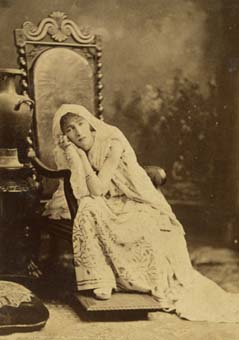Reflections in time: 19th century portrait photography
13 October to 11 December 2005
Art Gallery of New South Wales
 
Reflections in time explores the changes that occurred to international photographic portraiture in the nineteenth century. This period of photographic history demonstrates a revolution in artistic representation and social thinking. For the first time in history people could look at and scrutinize a likeness of themselves and others that was not comparable to the effect of a painting or drawing.
Early photography was largely the domain of the middle and upper classes, those who were wealthy enough to afford the cost and the time. When first invented, the daguerreotype - often called a "mirror with a memory" - was produced after a lengthy technical process in which the sitter had to remain stationary for up to twenty minutes. Reflections in time includes a number of these beautiful experiments with chemicals and silver-coated copper plates. Housed in traditional cases with velvet lining these daguerreotypes tell us a good deal about the people of that time, in terms of dress, taste and sensibility.
Reflections in time includes work by a number of artist photographers, including David Octavius Hill and Robert Adamson. Hill and Adamson are notable for their very early excursions into the aesthetic aspects of photography. For the period in which they were active as photographers their images are remarkable for their strong compositions and expressive qualities. Including portraits of children and women, their style is characteristically self-aware and allegorical.
With the development of cheaper and easier to manage photographic processes came the democratization of the photograph. By the end of the 1850s, the widespread public interest in portraiture developed hand in hand with the growth of photographic studios. Yet the business of photographic studios was largely driven by society's insatiable appetite for well-known faces. As one writer commented "The Imperial Prince, Queen Victoria and President Lincoln were quickly ousted by Sarah Bernhardt". Two images of Sarah Bernhardt, one of France�s leading actresses at the time, are included in the exhibition.
Including various photographic techniques - from daguerreotypes to gelatin silver prints - the exhibition illustrates how photography developed from a largely scientific pursuit to a widespread and popular activity. From the anonymous sitters reflected in the mirrored surface of a daguerreotype to the evocative portraits of David Octavius Hill and Robert Adamson, the exhibition reveals how changes in technology facilitated a more self-conscious awareness of the artistic possibilities of the photographic medium.
Reflections in time is drawn from the international collection of the Art Gallery of New South Wales and supplemented by loans from private Sydney collections. It includes work by David Octavius Hill and Robert Adamson, Julia Margaret Cameron, Napoleon Sarony, John Thomson and Baron Von Stillfried.
A brochure accompanies the exhibition.
Reflections in time: 19th century portrait photography
|